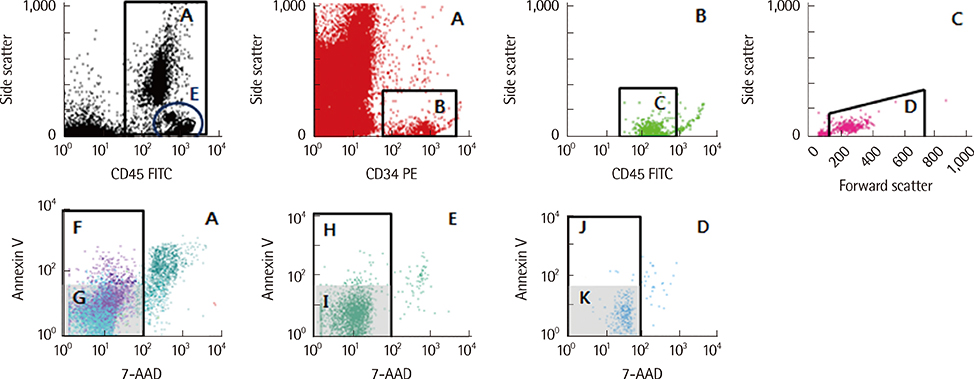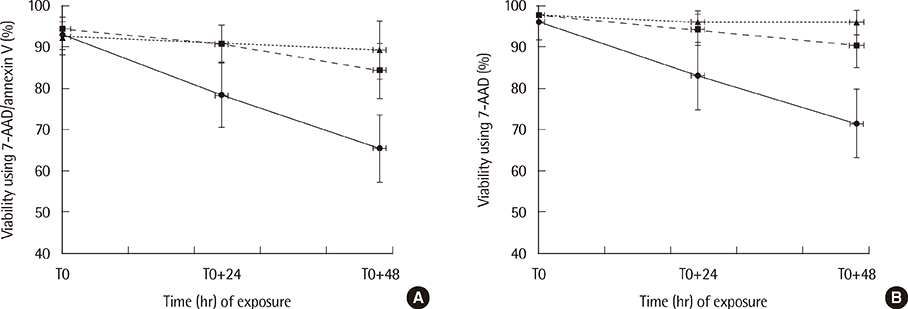Lab Med Online.
2014 Jan;4(1):1-7.
Assessment of Cell Viability in Umbilical Cord Blood by Using 7-AAD/annexin V Dual Staining
- Affiliations
-
- 1Department of Laboratory Medicine, CHA Bundang Medical Center, CHA University, Seongnam, Korea. olive@chamc.co.kr
- 2Department of Obstetrics & Gynecology, CHA Bundang Medical Center, CHA University, Seongnam, Korea.
Abstract
- BACKGROUND
The quality of cord blood largely depends on cell viability. Viability assessments using trypan blue or 7-aminoactinomycin (7-AAD) staining, which are commonly used methods, may not reflect early apoptosis of cord blood cells. We aimed to investigate early apoptosis in cord blood cells following elapsed time after collection using double staining with annexin V and 7-AAD and to compare the result with that of viability evaluation using trypan blue or 7-AAD staining.
METHODS
Umbilical cord blood samples were obtained from 30 pregnant women at the time of delivery between July 2012 and March 2013. Viability of cord blood cells was determined at 0 (T0), 24, and 48 hr after collection by using trypan blue exclusion assay, 7-AAD staining, and 7-AAD/annexin V staining.
RESULTS
Viabilities defined by 7-AAD/annexin V staining at T0, 24, and 48 hr after collection were respectively as follows: total nucleated cells, 92.8+/-4.5%, 78.4+/-7.8%, and 65.5+/-8.1%; mononuclear cells, 94.4+/-1.7%, 90.8+/-4.2%, and 84.2+/-6.7%; and CD34-positive cells, 92.4+/-3.0%, 90.7+/-4.7%, and 89.3+/-7.0%. The viability using trypan blue was more than 90% until 48 hr after collection.
CONCLUSIONS
The mean viability of total nucleated cells using 7-AAD/annexin V staining decreased to less than 80% at 24 hr after collection; however, the viability of CD34-positive cells was more than 85% until 48 hr. Our study's data will provide useful information for the assessing the quality of cord blood products.
Keyword
MeSH Terms
Figure
Reference
-
1. Wagner JE, Barker JN, DeFor TE, Baker KS, Blazar BR, Eide C, et al. Transplantation of unrelated donor umbilical cord blood in 102 patients with malignant and nonmalignant diseases: influence of CD34 cell dose and HLA disparity on treatment-related mortality and survival. Blood. 2002; 100:1611–1618.
Article2. Laughlin MJ, Eapen M, Rubinstein P, Wagner JE, Zhang MJ, Champlin RE, et al. Outcomes after transplantation of cord blood or bone marrow from unrelated donors in adults with leukemia. N Engl J Med. 2004; 351:2265–2275.
Article3. Rocha V, Labopin M, Sanz G, Arcese W, Schwerdtfeger R, Bosi A, et al. Transplants of umbilical-cord blood or bone marrow from unrelated donors in adults with acute leukemia. N Engl J Med. 2004; 351:2276–2285.
Article4. Solomon M, Wofford J, Johnson C, Regan D, Creer MH. Factors influencing cord blood viability assessment before cryopreservation. Transfusion. 2010; 50:820–830.
Article5. Louis I, Wagner E, Dieng MM, Morin H, Champagne MA, Haddad E. Impact of storage temperature and processing delays on cord blood quality: discrepancy between functional in vitro and in vivo assays. Transfusion. 2012; 52:2401–2405.
Article6. COBLT. Cord Blood Bank Standard Operating Procedures. Updated on Dec 2000. https://web.emmes.com/study/cord/sop.htm.7. FACT and NetCord. NetCord-FACT International Standards for Cord Blood Collection, Banking, and Release for Administration. Updated on Jan 2010. http://www.factwebsite.org.8. Ministry of Health and Welfare. The Umbilical Cord Blood Management and Research Act. Updated on Aug 2012. http://www.mohw.go.kr.9. Darzynkiewicz Z, Li X, Gong J. Assays of cell viability: discrimination of cells dying by apoptosis. Methods Cell Biol. 1994; 41:15–38.10. Xiao M, Dooley DC. Assessment of cell viability and apoptosis in human umbilical cord blood following storage. J Hematother Stem Cell Res. 2003; 12:115–122.
Article11. Shim JS, Cho B, Kim M, Park GS, Shin JC, Hwang HK, et al. Early apoptosis in CD34+ cells as a potential heterogeneity in quality of cryopreserved umbilical cord blood. Br J Haematol. 2006; 135:210–213.
Article12. Duggleby RC, Querol S, Davy RC, Fry LJ, Gibson DA, Horton RB, et al. Flow cytometry assessment of apoptotic CD34+ cells by annexin V labeling may improve prediction of cord blood potency for engraftment. Transfusion. 2012; 52:549–559.
Article13. Prasad VK, Mendizabal A, Parikh SH, Szabolcs P, Driscoll TA, Page K, et al. Unrelated donor umbilical cord blood transplantation for inherited metabolic disorders in 159 pediatric patients from a single center: influence of cellular composition of the graft on transplantation outcomes. Blood. 2008; 112:2979–2989.
Article14. Page KM, Zhang L, Mendizabal A, Wease S, Carter S, Gentry T, et al. Total colony-forming units are a strong, independent predictor of neutrophil and platelet engraftment after unrelated umbilical cord blood transplantation: a single-center analysis of 435 cord blood transplants. Biol Blood Marrow Transplant. 2011; 17:1362–1374.
Article15. Yi DY, Huh JY, Kang MS. Assessment of cell viability in umbilical cord blood before cryopreservation. Korean J Blood Transfus. 2010; 21:140–147.16. Cohen JJ, Duke RC, Fadok VA, Sellins KS. Apoptosis and programmed cell death in immunity. Annu Rev Immunol. 1992; 10:267–293.
Article17. Kerr JF, Wyllie AH, Currie AR. Apoptosis: a basic biological phenomenon with wide-ranging implications in tissue kinetics. Br J Cancer. 1972; 26:239–257.
Article18. Sparrow RL, Tippett E. Discrimination of live and early apoptotic mononuclear cells by the fluorescent SYTO 16 vital dye. J Immunol Methods. 2005; 305:173–187.
Article19. Schuurhuis GJ, Muijen MM, Oberink JW, de Boer F, Ossenkoppele GJ, Broxterman HJ. Large populations of non-clonogenic early apoptotic CD34-positive cells are present in frozen-thawed peripheral blood stem cell transplants. Bone Marrow Transplant. 2001; 27:487–498.
Article20. de Boer F, Dräger AM, Pinedo HM, Kessler FL, Monnee-van Muijen M, Weijers G, et al. Early apoptosis largely accounts for functional impairment of CD34+ cells in frozen-thawed stem cell grafts. J Hematother Stem Cell Res. 2002; 11:951–963.
Article21. Lee HR, Roh EY, Yoon JH, Han KS, Kim BJ, Hwang KR, et al. Analysis of maternal and neonatal factors affecting hematopoietic parameters of cord blood. Korean J Blood Transfus. 2009; 20:1–13.22. Colotta F, Re F, Mantovani A. Granulocyte transfusions from granulocyte colony-stimulating factor-treated donors: also a question of cell survival? Blood. 1993; 82:2258.
Article23. Dale DC, Liles WC, Price TH. Renewed interest in granulocyte transfusion therapy. Br J Haematol. 1997; 98:497–501.
Article24. Dale DC, Liles WC, Summer WR, Nelson S. Granulocyte colony-stimulating factor-role and relationships in infectious diseases. J Infect Dis. 1995; 172:1061–1075.
Article
- Full Text Links
- Actions
-
Cited
- CITED
-
- Close
- Share
- Similar articles
-
- Assessment of Cell Viability in Umbilical Cord Blood before Cryopreservation
- Difference in Viability of CD34+Cells in Cryopreserved Cord Blood According to Evaluation Methods
- Measurement of Apoptosis by Staining with 7-Amino-Actinomycin D with Concurrent Dual Color Immunofluorescence by Single Laser Flow Cytometry
- StemCell Transplantation in Umbilical Cord Blood(II) Characteristics of T-Lymphocyte Subpopulation in Umbilical Cord Blood
- Umbilical Cord Blood Stem Cell Transplantation



